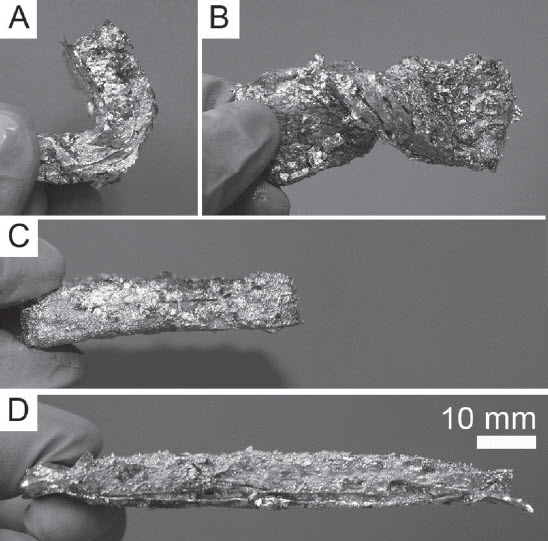A morphing metal for soft robots and other machines
March 22, 2016

Morphed configurations that demonstrate the composite’s ability to hold bent (A), twisted (B), relaxed (C), and elongated (D) positions at room temperature (credit: Ilse M. Van Meerbeek et al./Advanced Materials)
Cornell University engineering professor Rob Shepherd and his group have developed a hybrid material combining a stiff metal called Field’s metal and a soft, porous silicone foam. Think T-1000 Terminator.
The material combines the best properties of both — stiffness when it’s called for, and elasticity when a change of shape is required. The material also has the ability to self-heal following damage.
“Sometimes you want a robot, or any machine, to be stiff,” said Shepherd. “But when you make them stiff, they can’t morph their shape very well. To give a soft robot both capabilities, to be able to morph their structure but also to be stiff and bear load, that’s what this material does.”
In addition to its low melting point of 144 degrees Fahrenheit, Field’s metal was chosen because, unlike similar alloys, it contains no lead, making it biocompatible.
Cornell University | Metal Elastomer Composite
To create the hybrid material, the elastomer foam is dipped into the molten metal, then placed in a vacuum so that the air in the foam’s pores is removed and replaced by the alloy. The foam had pore sizes of about 2 millimeters that can be tuned to create a stiffer or a more flexible material. In testing of its strength and elasticity, the material showed an ability to deform when heated above 144 degrees, regain rigidity when cooled, then return to its original shape and strength when reheated.
His group’s work has been published in Advanced Materials and will be the cover story in an upcoming issue of the journal’s print edition.
The work was supported by the U.S. Air Force Office of Scientific Research, the National Science Foundation, and the Alfred P. Sloan Foundation.
Abstract of Morphing Metal and Elastomer Bicontinuous Foams for Reversible Stiffness, Shape Memory, and Self-Healing Soft Machines
A metal–elastomer-foam composite that varies in stiffness, that can change shape and store shape memory, that self-heals, and that welds into monolithic structures from smaller components is presented.